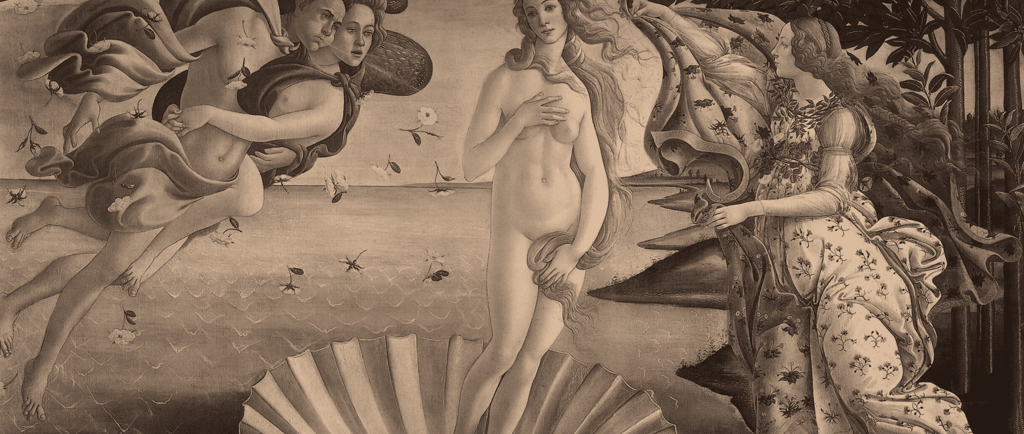The Birth of Venus: Botticelli’s Iconic Masterpiece Decoded
The Birth of Venus by Sandro Botticelli is more than a Renaissance painting—it's a visual symphony of mythology, symbolism, and enduring cultural influence. Painted around 1485 and housed in the Uffizi Gallery in Florence, this masterpiece remains one of the most recognized and discussed images in Western art.
Karolina K.
5/29/20252 min read


A Vision of Divine Beauty
At the heart of The Birth of Venus stands the goddess herself, emerging from the sea on a scallop shell, a symbolic birth tied to ancient Greek mythology. On her left, the wind god Zephyr blows her ashore, while on the right, a goddess—likely Flora—awaits to cloak her in a floral mantle. Venus’s flowing blonde hair and poised nudity capture both innocence and allure.
Her stance, known as the Venus Pudica pose, shows her attempting to shield herself, yet the gesture is far from panicked. This paradox—modesty intertwined with sensuality—has made the pose iconic across centuries of Western art.
Myth, Philosophy, and the Medici Connection
Commissioned by a member of the influential Medici family, the painting reflects the Neoplatonic ideals of the Florentine Renaissance. Philosophers of the time believed that earthly beauty could inspire spiritual growth—Venus wasn’t just a goddess of love, but a symbol of divine wisdom.
Influenced by the writings of Poliziano, a Medici court poet, Botticelli may have been inspired by ancient texts like the Homeric Hymns and Roman works like Ovid’s Metamorphoses. Still, his Venus diverges from these literary sources, hinting at visual inspirations from ancient sculpture, especially the classical Venus statues known in Tuscany.
Hidden Meanings: The Anatomy of Breath
One of the most fascinating modern discoveries in The Birth of Venus involves hidden anatomy. Scholars suggest that Botticelli embedded the image of lungs in the cloak held by Flora—a possible allusion to the "Divine Breath" that animates life.
This aligns with Renaissance interest in human anatomy and connects beautifully with the Neoplatonic theme: life itself is born of divine inspiration.
The Muse Behind the Goddess
Many believe Venus’s features were modeled after Simonetta Vespucci, a noblewoman celebrated for her beauty in Florence and rumored to be Botticelli’s unspoken love. She died young from tuberculosis, and Botticelli, who asked to be buried near her, may have immortalized her memory in this painting.
Her melancholic gaze and delicate features add emotional depth to the work, transforming Venus into a figure of both spiritual transcendence and mortal fragility.
Feminism, Queerness, and Cultural Legacy
What once symbolized divine beauty has evolved into a symbol of sexual empowerment, gender fluidity, and resistance. Venus’s ambiguous expression—neither overtly ashamed nor assertive—has been read as an act of silent defiance. Her image has been embraced by LGBTQ+ communities and feminist scholars as a symbol of transformation and self-possession.
Modern icons like Lady Gaga have referenced The Birth of Venus in music videos and album covers, using her image to express identity, power, and erotic liberation.
Why The Birth of Venus Still Matters
Botticelli’s The Birth of Venus isn’t just a relic of the past—it’s a living symbol. From classical mythology and Renaissance humanism to modern pop culture and gender theory, Venus continues to inspire and provoke.
Whether you’re a student of art, a lover of symbolism, or a seeker of beauty and meaning, this painting offers layers of insight waiting to be uncovered.
Discover It Yourself
Planning a trip to Florence? Don’t miss Room 10–14 at the Uffizi Gallery, where Botticelli’s masterpieces, including Primavera and The Birth of Venus, are on display.
This timeless artwork doesn’t just depict the birth of a goddess—it celebrates the eternal birth of beauty, power, and transformation.
Keywords: The Birth of Venus, Botticelli, Sandro Botticelli, Uffizi Gallery Florence, Venus Pudica pose, Botticelli paintings, Renaissance art, Florentine art, Venus in mythology
Contact
Contact us via email:
Subscribe to our newsletter!
office@tellmemoretravel.com
© 2025. All rights reserved.
